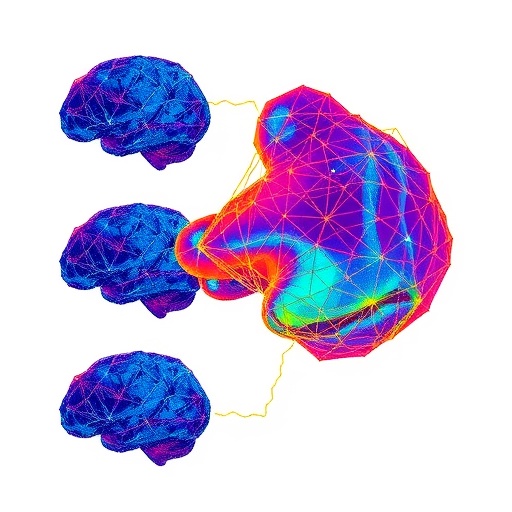Attention-deficit/hyperactivity disorder (ADHD) remains one of the most pervasive neurodevelopmental disorders affecting children worldwide, yet the complexity of its neural underpinnings challenges effective diagnosis and treatment. A groundbreaking study published in BMC Psychiatry in 2025 has ventured into a nuanced exploration of the brain’s functional connectivity (FC), dissecting low-frequency oscillations into distinct sub-bands to unravel the disorder’s intricate neurophysiological signature. This novel research harnesses cutting-edge machine learning techniques to explore how specific frequency ranges within resting-state functional magnetic resonance imaging (fMRI) data reveal unique patterns in children diagnosed with ADHD.
Traditionally, low-frequency blood oxygen level-dependent (BOLD) oscillations in the brain have been treated as a homogeneous band in functional connectivity analyses. However, this study challenges that paradigm by dividing these signals into three discrete frequency sub-bands: Slow3 (0.073–0.198 Hz), Slow4 (0.027–0.073 Hz), and Slow5 (0.010–0.027 Hz). This analytical refinement is pivotal because it corresponds to physiologically and functionally distinct neural processes, allowing researchers to pinpoint subtle alterations in brain activity with unprecedented clarity.
The study enrolled a cohort of 85 children, comprising 40 diagnosed with ADHD and 45 healthy controls, to meticulously evaluate resting-state FC differences across these frequency bands. Employing rigorous statistical tests alongside advanced machine learning classifiers, the researchers aimed to establish whether frequency-specific FC patterns could serve as reliable biomarkers, augmenting traditional clinical assessments that heavily rely on behavioral criteria.
Remarkably, the findings revealed frequency-specific alterations that challenge existing conceptions of ADHD’s impact on brain connectivity. In the higher frequency Slow3 range, increased functional connectivity was observed in the right precentral gyrus of children with ADHD. This region, known predominantly for its role in motor control and planning, has implications for the hyperactivity and impulsivity that characterize the disorder. The enhanced connectivity here suggests a neurofunctional basis for the motor dysregulation often reported in ADHD.
In the slower oscillatory bands, Slow4 and Slow5, the researchers noted a convergent pattern of increased connectivity in the right inferior frontal orbital region. This region has long been implicated in executive functioning, decision-making, and inhibitory control—domains often compromised in ADHD. The overlap of connectivity alterations in both these sub-bands led the investigators to merge them into a combined feature set for subsequent machine learning analyses, maximizing the discriminative power of the data.
The application of machine learning classifiers provided robust support for the clinical relevance of these frequency-specific findings. Using features derived from the Slow3 band, classification accuracy reached 79% for identifying ADHD subjects and 82% for healthy controls. The combined Slow4/Slow5 features further improved accuracy metrics, achieving 85% for ADHD detection and 80% for controls. These results underscore the potential of frequency-resolved FC as a non-invasive biomarker that could revolutionize ADHD diagnostics.
Moreover, receiver operating characteristic (ROC) curve analysis substantiated the predictive validity of these frequency-specific markers. The area under the curve (AUC) values, 0.7550 for Slow3 and 0.7830 for the combined Slow4/Slow5 bands, indicate substantial sensitivity and specificity. These performance metrics bring the promise of integrating neuroimaging biomarkers with clinical evaluations closer to reality, potentially mitigating diagnostic ambiguities that persist in pediatric psychiatry.
The research critically bridges a gap in ADHD literature by moving beyond generic low-frequency FC assessments. By parsing the BOLD signal into physiologically meaningful bands, it opens a vista into how the temporal dynamics of neural oscillations relate to the cognitive and behavioral dysfunctions hallmarking ADHD. This refined perspective invites reconsideration of current neurobiological models of the disorder and encourages targeted explorations of frequency-dependent neural mechanisms.
Furthermore, the involvement of specific brain regions identified in this frequency-specific analysis aligns with known cognitive deficits in ADHD, lending convergent validity to the findings. The right precentral gyrus’s role in motor functions complements the hyperactivity symptoms, while the inferior frontal orbital region’s executive functions relate to attention deficits, impulsivity, and emotional regulation challenges. This neural mapping provides a framework for linking neuroimaging biomarkers to symptom clusters, facilitating personalized intervention strategies.
Notably, the study design reflects a rigorous methodological approach, combining classical statistical inference with contemporary machine learning to enhance analytic power and characterization precision. Such hybrid methodologies exemplify the future of neuropsychiatric research, leveraging big data and algorithmic sophistication to unravel complex disorders with heterogeneous clinical presentations.
While these findings are promising, the authors acknowledge limitations, including the moderate sample size and the necessity to replicate results across diverse populations and developmental stages. Prospective longitudinal studies could elucidate whether these frequency-specific FC alterations represent stable neurobiological markers or fluctuate with symptom trajectories and treatment effects.
In sum, this pioneering research articulates a compelling narrative: parsing resting-state brain connectivity by frequency holds tremendous potential to reveal ADHD’s elusive neural signatures. This frequency-resolved approach not only enhances our mechanistic understanding but also points toward the development of novel diagnostic tools. As machine learning continues to evolve in neuroimaging applications, integrating these biomarkers with clinical workflows could transform ADHD management, enabling earlier, more accurate diagnoses and personalized therapeutic interventions that improve long-term outcomes for affected children.
Subject of Research: Frequency-specific alterations in resting-state functional connectivity in children with ADHD.
Article Title: Frequency-specific alterations in low-frequency functional connectivity in children with ADHD
Article References:
Fateh, A.A., Muhammed, H., Mohammed, A.A.Q. et al. Frequency-specific alterations in low-frequency functional connectivity in children with ADHD. BMC Psychiatry (2025). https://doi.org/10.1186/s12888-025-07586-6
Image Credits: AI Generated




